It was cold. It was dark. I was tired and ready for bed, but instead found myself heading for the front door. As I zipped up my jacket, my wife asked, her voice equal parts sleepy and annoyed, “Are you really doing this?”
The answer was yes, I was really leaving the house in the middle of a frigid November night to attend the launch of a video game system–the PlayStation 4, Sony’s first new home console since 2006.
A midnight release coupled with an all-nighter diving into Sony’s latest creation wreaked major havoc on my circadian rhythm (recovered at time of writing with several strategically timed macchiatos) but my late night trip and bleary-eyed weekend was worth it. Exploring the PS4 over the last 48 hours left a clear impression on my mind– gaming’s future has arrived.
Here’s why. For the past several decades, the goal of new console manufacturers has been focused on delivering one thing– more. More processing power, more graphic capabilities, more surround sound audio channels, more add-ons, more downloadable content, more online play, more everything. However, each advance and new feature set brought baggage along with it– load times, updates, patches, installations, etc. Playing video games changed from the immediate experience of the Atari and Nintendo days–insert cart, push button, play– to one that requires prerequisites. Enough hard rive space? Is the network connection up? Controller charged? By the way, have 20 minutes to perform a system update?
With the PlayStation 4, Sony has taken the first serious steps toward rolling back the hurdles that have crept up between players and playtime over the years, and they’ve done a brilliant job. You’ll read a lot about tech specs, new controllers, and launch title exclusives as Sony and Microsoft bring their newest generation of hardware to market, but this may be the first time in gaming history that the most important aspect of the generational upgrade is more philosophic in nature than technical. While technological advancement is important and high performance graphics are always fun to behold, the centerpiece “killer app” of the Sony PlayStation 4 is the tangible sense that it was purpose-built to connect players to games as quickly as possible. It delivers, in a word, experience. From top to bottom, the PS4 is a fluid, responsive machine that allows for immediate access to its core offering– games. It’s a welcome return to form for Sony and for home gaming overall.
First impressions
I had low expectations for the PS4’s day one performance. Maybe it’s because I pre-ordered months in advance and my manic nerves have been long frazzled, perhaps it’s a byproduct of reading too many media reports or being a longtime Nintendo fan (my Wii U launch blog is still saved in drafts, soaked in tears). More directly, it was likely the rocky launch of Sony’s previous console, the PlayStation 3, that had me on edge. When Sony introduced the PS3 in 2006, the company was king of the console world. The PS3’s astronomical price tag and convoluted supercomputer architecture that limited third party development took Sony from 70% market share down to parity with Microsoft. Unlike the ubiquitous and world-dominating PS2, the PS3 seemed to alienate its user base. It took a massive marketing overall (adios, Spiderman font), console redesign, and a price drop in 2009– effectively a second launch– to shape the PS3 into something more in line with Sony’s historic console line up. This is all swirling in my mind as I stand in line to pick up the PS4, sipping coffee and anticipating another nugget of regret to be notched int the belt of my life.
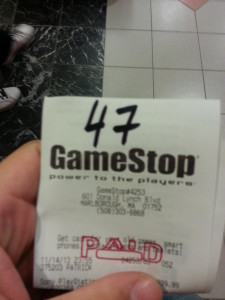
Console acquired from the good folks at GameStop followed by dreary ride through the New England woods and I’m back home at about 1 a.m., stealthily installing the PS4 in my living room. I crack open the box expecting a project, but I’m greeted instead by simplicity. The console itself is small and light. There’s a bank of ports on the machine’s back– HDMI, power, Ethernet, optical, and a proprietary port for the camera add-on I’ll never buy. The slanted front of the box obscures two USB ports and the blu ray drive. It’s a neat and tidy design. On outward appearance alone Sony has surpassed the PS3 experience for me. I slide the PS4 into my entertainment center and fling the suddenly garish and obsolete PS3 aside like an old dog toy. The transition takes all of two minutes.
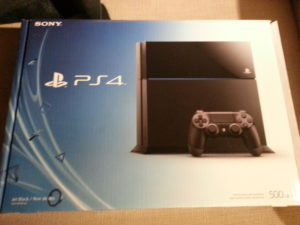
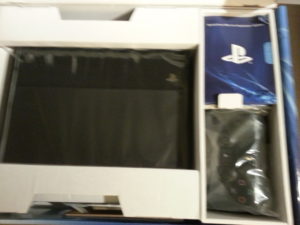
Power up, moment of panic as TV doesn’t automatically click on as it did with the PS3 (turns out HDMI to TV linkage is an option that needs to be turned on via the PS4s settings). I sigh audibly, having been forced to turn on my TV and manually select source input like its 1984. Another sigh. Progress sucks.
Then, glorious boot screen. It’s the kind of corporate blue that makes me agreeable to horrible terms of service. I click through contract nonsense and go through the basic account setup stuff. Immediate thoughts – Wow, this sucker is fast.
This is as good a time as any to point out that Sony has redesigned their console controller. The DualShock 4 is far more comfortable than any controller Sony has previously produced and very well may be a step toward singularity. It’s sweet. There’s also a nifty touchpad that clicks like a mouse and a light bar that, well, provides light.
The system’s user interface is very responsive and has a brilliant above/below the fold structure. The above section houses the spiritual success to Sony’s XMB menu bar used on the PS3 and portable devices. A row of icons ranges from the PlayStation Store to Power, with profile, party chat, and system settings in between.
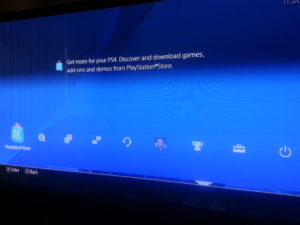
Took about an hour for Sony’s PSN to become available. Once logged in, I watched as my account information and legacy PS3 trophies were imported. I then registered the included 30-day trial of PlayStation Plus and set about linking my Facebook account to PSN. The social component is everyone in the PS4, yet never gets in the way of functionality. The ability to stick with a PSN gamer handle or use your real name is cool.
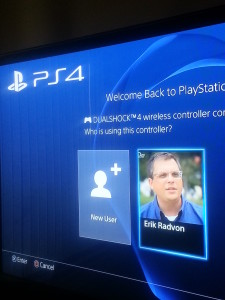
Launch Titles
Surveying the PS4s launch day titles, it was clear there was no console shipping flagship ala Super Mario 64. There is variety though and enough available to hold early adopters over until 2014, when Sony promises to unleash a bevy of exclusives and AAA titles like Destiny. On launch day, I faced down the options. LEGO Marvel Superheroes looked fun, but it’s simplistic style didn’t exactly cry out “next gen console showcase” to me. Sony’s all-ages exclusive KNACK, produced by Mark Cerny, who was responsible for Crash Bandicoot and served as lead designer of the PS4 itself, caught my eye. While I’m a fan of platformers (Little Big Planet uber alles) something in my gut told me to pass on Knack.
For my test batch of launch titles, I selected Sony’s Killzone Shadow Fall and EA’s FIFA 14. I don’t play many shooters, but I was impressed by Sony’s previous entries in the Killzone series. Killzone 3 in particular delivered enormous set pieces (gimmicky as it may be, Killzone 3 in 3D is on par with a theme park experience).
Killzone Shadow Fall has some amazing graphics. Sparkling cityscapes, dark industrial structures, and forest vistas all look beautiful. The lighting effects are jaw dropping. The bevy of smoke, steam, sparks, and atmospheric flourishes all work in tandem to create a strong sense of environment and mood. The game uses the DualShock4’s touchpad in an inventive way, and also makes use of the controller’s light bar. When your health is good, the light is green. Get shot, it turns red. It’s a shame all this technological wizardry is grafted on to what is an otherwise stale, uninspired shooter. Killzone Shadow Fall is frustrating because all the elements for a great launch title are there, but they rarely fuse in any meaningful way. Don’t get me wrong, Shadow Fall is enjoyable. The game is hampered by its first three muddled stages, but comes to life in its fourth chapter. It’s a challenging shooter, with tough enemies and ruthless resource allotment. Also, your character gets a drone. So there’s that. It’s a good enough game, but at $60 I’d hold off for a price drop. That said, the graphics alone make it a pretty hot demo reel for showing of the PS4, so early adopters may be enticed to take the hit.
FIFA 14 delivers mostly what one would expect from the long franchise. The PS4 version is fast. Insert the disc and you can be playing a match in a matter of moments. Long load times are gone, and the game’s graphics are top notch. I’ve played about a dozen matches thus far and each has been smooth. It’s super fast. I’ve had a lot of fun with it and expect to get my money’s worth. Usual complaints about EA’s online services apply. The EA account requirements for online play and access to additional content feels burdensome.
The End of the Beginning
This was a quick and dirty rundown of Sony’s new console through bleary eyes and can best be called a first glance. There are many features of the console I haven’t touched on or yet had time to experience (damn you, laundry). Overall, in this brief crash course the PS4 has exceeded my expectations. It’s a gaming console that delivers connectivity, functionality, and experience that doesn’t feel like a chore to use. Sony has made a massive investment in what I call “virtual ergonomics”, smartly using its new technology platform to circumvent, minimize, and obfuscate the load times and update limbos that gamers have been wallowing in for a decade. The console presents a streamlined, nimble experience and leaves you wanting to use it more. To borrow from Sony’s tagline, greatness surely awaits the PS4. With some wise technology decisions, a phenomenal new controller, and a dedicated focus on the user experience, Sony has taken gaming to the next level. Now let’s how some fun with it.